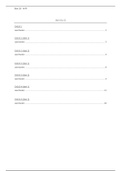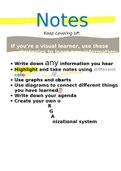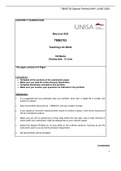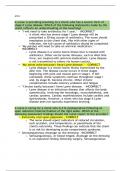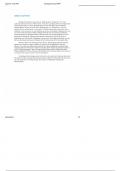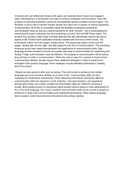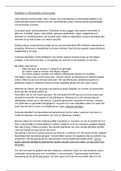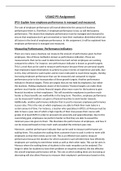HRM – aantekeningen en samenvatting
Hoorcollege Gekeken: Herhaald: Geleerd: Opmerkingen:
1 Ja Ja Ja Boek lezen people parner, talent
partner, business partner,
Pfeffer’s seven best
practices
2 Ja Ja Gastcolleges kijken + vragen Q&A nog
even toevoegen
3 Ja ja
4 Ja ja
5 Ja ja
6 Ja ja
7 Ja Ja
8 Ja Ja
9 Ja Ja
10 Ja ja
Planning
Woensdag Samenvatting helemaal herhalen + bijbehorende artikels
en oefentoets
Donderda Boek lezen + herhalen
g
Vrijdag
Zaterdag Boek lezen 10, overig herhalen
Zondag Herhalen
Feedback presentation:
Parts of hr-strategy scan were well
HR part what were the practices?
Little bit more support for our reasoning
Fit part is speculative how is this a fit? Distinguish between facts and reasonings.
,Hoorcollege 1: HRM en Strategic HRM. (Boek: boselie, 2014)
HRM involves management decisions related to policies and practices that
together shape the employment relationship and are aimed at
achieving individual, organizational and societal goals. for example: what
policies and practices do we need to become more diverse?
There are 4 sorts of Employment relationships:
1. Legal contract = attired to the law and legally banding. (number of
holidays, confidentiality issues, etc.) [Rights and obligations]
2. Economic/transactional contract = has to do with agreement
that employees and their organization have about the effort that an
employee puts in towards the organization and the reward that they
get from the organization for that effort. (for example: effort =
number of working hours/days, etc. reward = getting paid) [effort
and reward]
3. Psychological contract = not formally written down. Expectations
of organizations and employees. [informal mutual expectations]
4. Sociological contract= relationships and networks that employees
have between an organization. [relationships and networks]
As part of the recruitment process, Jamie and his new manager, Lisa, discussed the
number of customers he would be expected to visit in a typical week and the
challenges he might need to face when trying to secure a sale at each of them. They
also discussed the various bonus-schemes that the company had in place for their
salespeople.
What part of their employment relationship did this conversation relate to?
economic contract
Strategic Human Resource Management (SHRM) pays extra
attention to the organizational context, i.e. the alignment of HRM
(practices) with:
Business strategy: normal requirements? What are others doing?
External context: market, legal context, values society
Business systems: how things are operated, system the organization
uses to run
Each other: how policies and practices work together and ally with
each other
for example: how does this fit with the business strategy: what are
expectations from people outside the organization? What kind of policies
and practices do we need to achieve a goal that is in line with those
expectations? You can look at the business strategy, the external context,
business systems, or the context with each other.
,Micro HRM (MHRM): micro HRM has to do with individual policies and
practices that an organization is trying to use or develop or make
decisions about rather than all the different policies and practices that
they’re involved in specific practice: training or recruitment to help
diversity within an organization, make people less biased, etc.
for example: individual HRM practice training/recruitment within
organization, like specific practice: help diversity within an organization,
make people less biased.
International HRM (IHRM): HRM in an international context. for
example: how do we do this across different countries in which our
organization operates?
Alignment between different practices and organizational context
is often to referred to as fit. We distinguish different types of fit:
Strategic (vertical) fit: fit between HR policies and practices and
the strategy of the organization
Internal (horizontal) fit: fit between HR and other HR
practices, so the policies and practices that an organization has
with each other, (i.e. around recruitment)
Organizational fit: fit between HR policies and practices and other
organizational systems, i.e. procedural systems that an
organization has.
Environmental or institutional fit: fit HR policies and practices
with legislation, norms and management fashions
In an organization, there isa good alignment between the recruitment practice and
the promotion practice.
How is referred to? Horizontal fit
Best practice approach you’re trying to identify the very best way to do
things within your organization (i.e. recruitment, rewarding people,
motivating people & evaluating people).
Pfeffer’s seven best practices
High performance work systems (3rd lecture)
Best fit approach:
The strategy scan (today + 2nd lecture) About the best fit with the context.
High-performance work systems are an example of which approach to HRM? best
practices approach
Strategy: what are the goals? Practices: around selection and recruitment
HR Strategy scan (Best fit approach)
, We are going to consider the fit between these practices within the
organizational context.
External general/population market context (all about market
context, money, economic context)
The external general/populational institutional context: everything
else that is going on, has nothing to do with economic context. More
about agreements, rules, etc.
During Q&A:
Approaches to HRM:
Anglo-Saxon or Anglo-American models: Focus on shareholder
value (profit, market value)
Rhineland models: Acknowledge multiple stakeholders and their
interests. Explicitly take into account employee interests in terms of
wellbeing, and societal interests
The strategic balance model: “Success can only be achieved
when financial performance and societal performance of an
organization are above average in the particular population in which
the organization is operating.”
Mini-case:
Lecture 2 – 1
1980 Ricardo Semler joins Semler & Co
• Owner and CEO: Antonio Semler
Economic downturn
Ricardo Semler takes over as owner & CEO
• fires 60% of top managers on 1st day
• diversifies production (products for shipbuilding from 90% to 60%)
• Increases control
Hoorcollege Gekeken: Herhaald: Geleerd: Opmerkingen:
1 Ja Ja Ja Boek lezen people parner, talent
partner, business partner,
Pfeffer’s seven best
practices
2 Ja Ja Gastcolleges kijken + vragen Q&A nog
even toevoegen
3 Ja ja
4 Ja ja
5 Ja ja
6 Ja ja
7 Ja Ja
8 Ja Ja
9 Ja Ja
10 Ja ja
Planning
Woensdag Samenvatting helemaal herhalen + bijbehorende artikels
en oefentoets
Donderda Boek lezen + herhalen
g
Vrijdag
Zaterdag Boek lezen 10, overig herhalen
Zondag Herhalen
Feedback presentation:
Parts of hr-strategy scan were well
HR part what were the practices?
Little bit more support for our reasoning
Fit part is speculative how is this a fit? Distinguish between facts and reasonings.
,Hoorcollege 1: HRM en Strategic HRM. (Boek: boselie, 2014)
HRM involves management decisions related to policies and practices that
together shape the employment relationship and are aimed at
achieving individual, organizational and societal goals. for example: what
policies and practices do we need to become more diverse?
There are 4 sorts of Employment relationships:
1. Legal contract = attired to the law and legally banding. (number of
holidays, confidentiality issues, etc.) [Rights and obligations]
2. Economic/transactional contract = has to do with agreement
that employees and their organization have about the effort that an
employee puts in towards the organization and the reward that they
get from the organization for that effort. (for example: effort =
number of working hours/days, etc. reward = getting paid) [effort
and reward]
3. Psychological contract = not formally written down. Expectations
of organizations and employees. [informal mutual expectations]
4. Sociological contract= relationships and networks that employees
have between an organization. [relationships and networks]
As part of the recruitment process, Jamie and his new manager, Lisa, discussed the
number of customers he would be expected to visit in a typical week and the
challenges he might need to face when trying to secure a sale at each of them. They
also discussed the various bonus-schemes that the company had in place for their
salespeople.
What part of their employment relationship did this conversation relate to?
economic contract
Strategic Human Resource Management (SHRM) pays extra
attention to the organizational context, i.e. the alignment of HRM
(practices) with:
Business strategy: normal requirements? What are others doing?
External context: market, legal context, values society
Business systems: how things are operated, system the organization
uses to run
Each other: how policies and practices work together and ally with
each other
for example: how does this fit with the business strategy: what are
expectations from people outside the organization? What kind of policies
and practices do we need to achieve a goal that is in line with those
expectations? You can look at the business strategy, the external context,
business systems, or the context with each other.
,Micro HRM (MHRM): micro HRM has to do with individual policies and
practices that an organization is trying to use or develop or make
decisions about rather than all the different policies and practices that
they’re involved in specific practice: training or recruitment to help
diversity within an organization, make people less biased, etc.
for example: individual HRM practice training/recruitment within
organization, like specific practice: help diversity within an organization,
make people less biased.
International HRM (IHRM): HRM in an international context. for
example: how do we do this across different countries in which our
organization operates?
Alignment between different practices and organizational context
is often to referred to as fit. We distinguish different types of fit:
Strategic (vertical) fit: fit between HR policies and practices and
the strategy of the organization
Internal (horizontal) fit: fit between HR and other HR
practices, so the policies and practices that an organization has
with each other, (i.e. around recruitment)
Organizational fit: fit between HR policies and practices and other
organizational systems, i.e. procedural systems that an
organization has.
Environmental or institutional fit: fit HR policies and practices
with legislation, norms and management fashions
In an organization, there isa good alignment between the recruitment practice and
the promotion practice.
How is referred to? Horizontal fit
Best practice approach you’re trying to identify the very best way to do
things within your organization (i.e. recruitment, rewarding people,
motivating people & evaluating people).
Pfeffer’s seven best practices
High performance work systems (3rd lecture)
Best fit approach:
The strategy scan (today + 2nd lecture) About the best fit with the context.
High-performance work systems are an example of which approach to HRM? best
practices approach
Strategy: what are the goals? Practices: around selection and recruitment
HR Strategy scan (Best fit approach)
, We are going to consider the fit between these practices within the
organizational context.
External general/population market context (all about market
context, money, economic context)
The external general/populational institutional context: everything
else that is going on, has nothing to do with economic context. More
about agreements, rules, etc.
During Q&A:
Approaches to HRM:
Anglo-Saxon or Anglo-American models: Focus on shareholder
value (profit, market value)
Rhineland models: Acknowledge multiple stakeholders and their
interests. Explicitly take into account employee interests in terms of
wellbeing, and societal interests
The strategic balance model: “Success can only be achieved
when financial performance and societal performance of an
organization are above average in the particular population in which
the organization is operating.”
Mini-case:
Lecture 2 – 1
1980 Ricardo Semler joins Semler & Co
• Owner and CEO: Antonio Semler
Economic downturn
Ricardo Semler takes over as owner & CEO
• fires 60% of top managers on 1st day
• diversifies production (products for shipbuilding from 90% to 60%)
• Increases control


